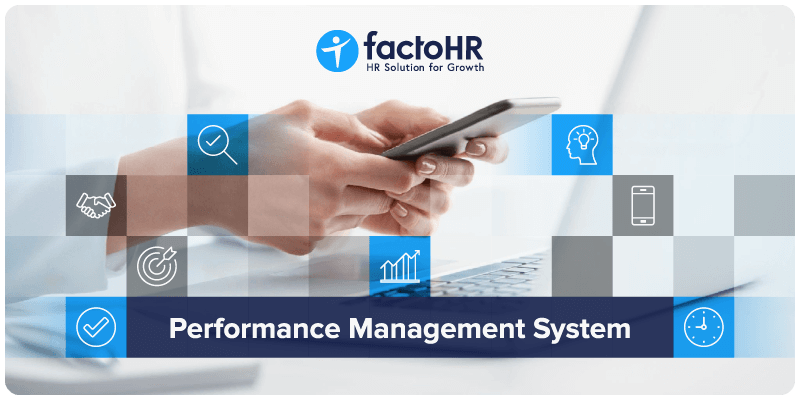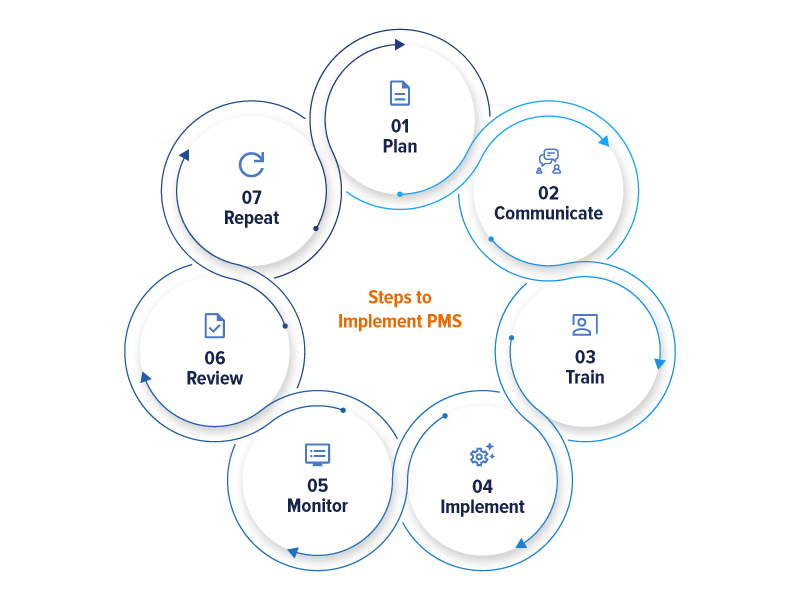Performance Management System - A Complete Guide

Table of Contents
Performance management simply is evaluating the employees’ performance based on the set goals at regular intervals. Although this terminology is not new for organizations, but its origin is age-old. Let’s get back to the evolution of the performance management system and look at how it started.
The process of performance evaluation was invented by Walter D.Scott at the time of the first world war (1914-1918), introducing the concept of man-to-man comparison. It started when a problem arose regarding the selection of officers and staff members. Scott then developed a rating scale, and from its success, the concept of performance evaluation originated to rate the abilities and productivity of his employees. However, the idea did not gain much popularity at that time, and around the 1950s, companies’ shifted towards formal performance appraisals based on the employees’ personalities. As years passed, the performance management system evolved, and the 1980s was a turning point where 360-degree feedback and multi-person rating became popular. Till 2010 companies shifted to continuous feedback by adopting tech tools and left the traditional methods behind.
Organizations continuously tried to improve the performance management processes as they figured out its critical for surviving in a hyper-competitive age. Gradually, companies also found that performance management is helpful in aligning the employees’ goals with the organizational goals. The need is not just limited to alignment but even for identification of training needs, having clarity, improving employees’ productivity, and rewarding the top performers’ accurate performance evaluation is a necessity.
Performance management might seem simpler, but that’s not the case every time. Implementing a system that works well as per the needs of the organization can be tedious and difficult for small, medium, or tech-averse organizations. But, due to the commoditization of technology and the availability of cloud-based performance management software, these challenges can be easily overcome by any size and type of business
Are you yet to adopt a performance management process in your organization? or do you want to redefine your performance management process and make it powerful? If your answer is yes to any of the questions, then this article will provide you with a 360-degree overview of performance management system, its types, benefits, current trends, and much more.

What is a Performance Management System (PMS)
A performance management system is a strategic tool used by organizations to track, measure, and improve employee performance. By aligning individual goals with business objectives, it drives productivity and ensures employees contribute to company success. The system typically includes performance appraisals, feedback, and development plans, leveraging technology to provide a measurable, consistent framework for growth and continuous improvement.
It becomes necessary for the superiors to set a target, delegate them to the employees and then evaluate its completion and the final results. When this process is conducted through strategic planning, it will bring out the gaps and will result in a refined process. But, all this could only be possible when the PMS is strong. You would have got the idea of why PMS is necessary. Further, the objectives are expanded with its cycle and key elements.
Objectives of Performance Management System in HRM
After understanding what PMS is, you must have got some idea about its importance and need. Below mentioned are the key objectives behind organizations adopting PMS:
Effective communication between managers and employees
Continuous communication between employees and managers is necessary for setting clear objectives and expectations. Managers need to define what they expect from an employee and how they need to conduct them. When there are no gaps and miscommunication, the organization reaches near to its goals.
For setting performance standards
It is essential to set the objectives initially because the performance of employees has to be compared to some standards. Defining the standards for each role is a prerequisite to measuring the employees’ performance and knowing what is lacking and what needs appreciation.
Identification of skill gaps
Efficient performance management can help the organization find the existing skill gaps in employees. It becomes easier for the managers to identify the gaps when the system enables practical and clear communication, goal setting, and assessment.
Transparent and fair performance appraisal
Appreciating employees for their contribution is essential, but outstanding performances can only be identified when an assessment is done correctly. Therefore, a robust performance evaluation system is required to treat the employees fairly.
Performance growth and organizational development
One of the prominent ways of organizational development is the constructive and productive performance of employees. Setting goals collectively and providing continuous feedback through PMS can eventually lead to better performances and growth.

Process of Implementing Performance Management System
Having an effective PMS makes the difference and helps an organization achieve its objectives and retain employees. Research has shown that the 69% of employees believe they would work harder if their efforts were recognized. This is possible when companies evaluate the performances correctly and timely. Below are the steps to successfully implement PMS:

Plan
The first and foremost stage of this process is to manage it strategically and plan with a clear idea of what you expect from the new system. Keep in mind the objectives of performance reviews in mind and decide the way to proceed.
Communicate
Communicating about the changes in performance evaluation with the employees is necessary to familiarise them with the new system and get their acceptance. Employees should be aware of the way their performance will be evaluated and should find it fair.
Train
Managers may need the training to get hands with the new performance management system. It is a necessary step as it will fill the existing gaps and provide the required knowledge and skills to make the implementation easy.
Implement
Always implement a pilot version, as it will help identify the changes required to keep the performance aligned with the organizational goal. Here managers and employees will both get real-time experience.
Monitor
After the implementation stage, monitor how the analysis is going on, what no.of employees are evaluated, and the quality of information gathered by the system. Monitor all the points that are essential for your organization.
Review
Re-evaluate the capabilities of the system and see whether all of them are utilized in the right way. Review whether the objectives and goals of implementing the PMS are fulfilled or not. Make changes if required as per the review and feedback.
Repeat
Lastly, implement the PMS after ensuring all the steps are followed, and actions are taken for the betterment of the process. Inform managers and employees to follow the same process and repeat the cycle.

Benefits of Performance Management System
A faultless performance management process will have multiple positive impacts, and they can vary as per the organization. Here we have mentioned some common benefits that organizations can received with the implementation of PMS:
Evaluation of employees’ performance on standardized metrics
When the performance management process is designed systematically, and the process is equally applicable to all the employees with a set standard of metrics used, it brings consistency and transparency.
Appreciating top performers and fulfillment of training needs
Evaluating employee performances accurately helps the management identify the skill gaps, and their training needs are fulfilled. Also, the top performers can be identified and appreciated.
Improved employee motivation
Appreciating the employees for their efforts brings a sense of belongingness and increases their motivation and satisfaction.
Reduced employee turnover ratio
When the employees are satisfied, they will be willing to work with the same organization for a longer time, and thus the employee turnover ratio decreases.
Automated and time-saving
The process gets automated with the software. As feedback can be given to employees continuously, the errors are solved in mid-course, saving time later.

Types of Employee Performance Evaluation
The core part of performance management is evaluating employee performances. However, as per the organization and job roles, performance assessment and evaluation methods can differ. Therefore, from different approaches, organizations have to choose the one that best suits them as per the need.
If you are confused about which method to choose, below 5 different methods are explained. Read about all other ways and choose the one that is the right fit for your organization.
Management by Objective (MBO)
Management by Objective method is a strategic approach where the focus is to define the goals and objectives on which employees have to work. This approach aims to have a clear idea about the company’s objective and purpose of all the actions. When the end objective and goal are clear in the employee’s mind, it will keep them aligned. MBO is about setting the objectives and goals of the company collectively and emphasizing the employees to work towards them.
MBO has mainly three types. First is the team development objective, where the objectives are set for the overall development of the teams. The second is the individual development objective, where the goals are set only for individual employees. And another one is the strategic development objective, where the objectives are for the organization’s overall development. The process of MBO has the following steps:
- Establish Goals– Setting long-term goals
- Set Employee Objective– Setting up individual goals of the employee
- Monitor the Performance– Monitor the performance as per the goals
- Evaluate Performance– Evaluate the end results
- Provide Feedback– Giving feedback to employees on their work
- Performance Appraisal– Appreciating the employee for their performances
Read More: Process of MBO and FAQs
360-Degree Feedback
As the name suggests, this method collects feedback from multiple sources. Communicating with other employees and managers collectively brings better feedback. The technique emphasizes communicating both with employees and managers. Employees are given feedback from multiple sources like superiors, customers, colleagues, or subordinates. Also, employees can provide feedback to themselves. Rather than just depending on one source, collecting the responses from various places will bring different opinions in front.
Most of the time, companies prefer preparing a feedback questionnaire that includes various aspects and different competencies like leadership or communication skills. The method helps the employees get various feedback and easily communicate with their superior and discuss. Performance management gets simple and also builds a culture where employee development is continuous.
Read More: Examples and FAQs of 360-degree feedback
Behaviorally Anchored Rating Scale (BARS)
Behaviorally Anchored Rating Scale (BARS) is an employee performance evaluation method where both qualitative and quantitative data are collected and assessed. This analysis method is one of the oldest and is based on the critical incident method for defining the behaviors. It works in a way where the behavioral categories are initially defined and assigned a numeric value. Then the employees are rated for the different behavior categories. Through this method, employers can assess employees at each stage, say at the time of recruitment and after joining.
Larger companies usually adopt the BARS method as it consumes less time. The categories and their ratings are once specified, and then the process does not need much explanation; therefore, it saves managers time. Also, the method assures consistency as very few changes are required sometimes. And the chances of partiality are also low, as the behaviors are evaluated and not the individuals.
Read More: Examples and FAQs of BARS
Objective and Key Result (OKR-Based)
Objectives and key result is a performance evaluation method where set objectives, and then the key results are measured and evaluated. The technique is beneficial for the organization to directly align the organisations’ goals with the employees’ objectives. It also enables managers and employees to communicate prior to setting the objectives and avoid any confusion.
The main element of OKR-based performance management is transparency. When the managers and employees are able to discuss the objectives, it brings openness and clarity to the organization. Up to some extent, it is also time-saving and requires fewer resources. The best part is employees can clearly identify their role and contribution to the organizational goal, and managers can easily evaluate it against the set standards.
Self-Evaluation
Self-Evaluation is an entirely different method compared to all other approaches, as employees evaluate themselves here. Employees have to self-review their performance on the predefined criteria or indicators. This method is adopted by organizations to bring self-awareness among the employees. When employees review their own work, they will have a better idea and awareness of their accomplishments and shortcomings.
Also, it results in saving managers time as they do not need to get involved at various stages. Another aspect of this approach is that employees are able to justify and clarify their own work precisely, which managers, in some cases, can miss out. Mainly before the appraisals, employees are asked for self-evaluation.

Current Trends of PMS
Workplace dynamics are changing as per the time now. Especially after the pandemic, the scenarios in the workplace are changing. With the adoption of work from home and flexible working models, monitoring the employees is becoming difficult. To overcome the challenges, systems to manage performances have been upgraded. Below mentioned are the current trends of PMS:
Collaborative and Flexible System
Organizations and their employees urged to have a system that offers more flexibility. They wanted to have a single platform that collaborates with employees and is also flexible enough to work similarly when the workforce is working from home or has a hybrid model. Most of the solutions available are now flexible and fit the employers’ needs.
Real-Time Data and Human Experiences
Making important decisions like performance evaluation can not be based on assumptions; it needs to be data-driven. To get the best out of the performance management process, organizations need real-time data on which they can take action. Employees want their organization to treat them as people, not just employees. Therefore, employees also want to include various aspects such as personal well-being while evaluating their performance.
Continuous Interactions and Feedback
Gone are the days when the annual performance reviews worked. But now, to bring effectiveness and efficiency to the process, continuous interaction between managers and employees is required. As a result, there will be a massive shift from annual reviews to ongoing reviews, and that market is projected to grow at 13% of the compound annual rate. Providing feedback while the projects or work is ongoing makes the scope of improvement and development vast.
How to Choose the Right Performance Management Software for your Organization

It can be challenging and conflicting for organizations to choose the right performance management software, especially when they have various options. So, we are here to provide you with a step-wise guide that will help you choose the right PMS:
Establish your goals, needs, and requirements
Analyzing is the first and crucial step. Identify the pain points and requirements in comparison to your end goal. Next, decide which functionalities and integrations you need. Prepare a checklist including them all and move to the further step keeping them in mind.
Estimate and allocate a budget
Once you are clear with your needs, make the budget estimation. Involve the finance department if needed for better clarity and to avoid any miscalculation. Consider the total costs, which also include the implementation and maintenance.
Create a list of vendors and shortlist
When the needs and budget are precise, shortlist all the vendors that fall in that category. Again, comparing all the providers will be beneficial as you will come to know all the pros and cons of choosing any one of them. Always ask for a trial period from vendors.
Communicate with end-users and decide
Communicate with all the members that are to be involved in the process. You will come across different opinions and viewpoints for the betterment of the organization. Lastly, consider and recheck all the aspects and decide the one that fulfills all the requirements.

Top 5 Companies Providing Performance Management Software
factoHR
factoHR is an OKR-based performance management software that aligns the organizational goals and performance evaluation. It is an all-in-one solution to enhance organizational growth through empowering employees. Features of software are such that it fulfills the modern needs of the organization and is in accordance with the current trends.
Some of the attributes we offer are:
- Analytics through the pre-built dashboard
- Review cycles that are configurable
- Payroll module linked with performance management
- Hierarchical workflow and continuous reviews
- Supported by a Mobile application
Namely
Namely is a performance management solution designed for mid-sized companies. Along with the talent management solution, they have newly introduced the employee reporting solution. They offer goal alignment, goal tracking, 360 feedback, and appreciation features.
Paylocity
Paylocity is a performance management tool that enables two-way interactions for a fair performance evaluation. The software can be integrated with the existing systems and is flexible enough. Some of the other features are goal management, full-scale feedback, and key data metrics.
Talentguard
Talentguard is another effective performance management solution that can generate continuous feedback and reviews. The software is used by companies from different industries like banking and biotech. The key features are the managers’ dashboard to view teams’ progress, appraisals and evaluation, and development options with learning and coaching tips.
SyncHR
SyncHR is an employee performance evaluation tool designed for modern workplaces. They believe things will only get managed when they are measured; therefore, they are employee-centric. They offer 1:1 job coaching, plan development, goal tracking, and 360-degree feedback.
Choose a Performance Management System that Makes a Difference
Having required employees, looking at what and how they will work, and lastly, keeping up the performance management system are prerequisites for success. Therefore choosing the system that rightly fits your organization will make all the difference. Get factoHR’s free demo for the performance management system and empower your employees by aligning your organizational goals and observe the difference.
Grow your business with factoHR today
Focus on the significant decision-making tasks, transfer all your common repetitive HR tasks to factoHR and see the things falling into their place.

© 2025 Copyright factoHR


